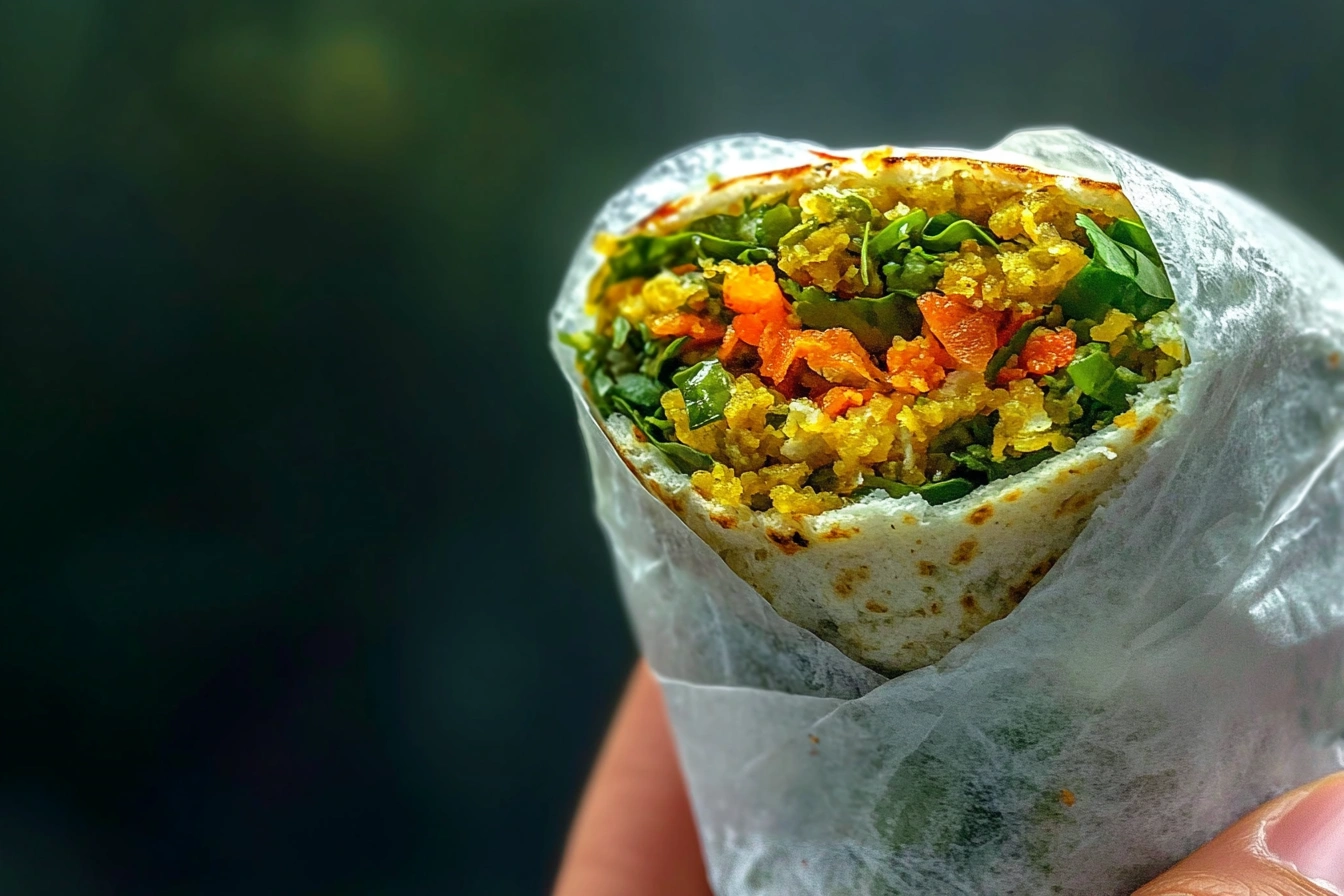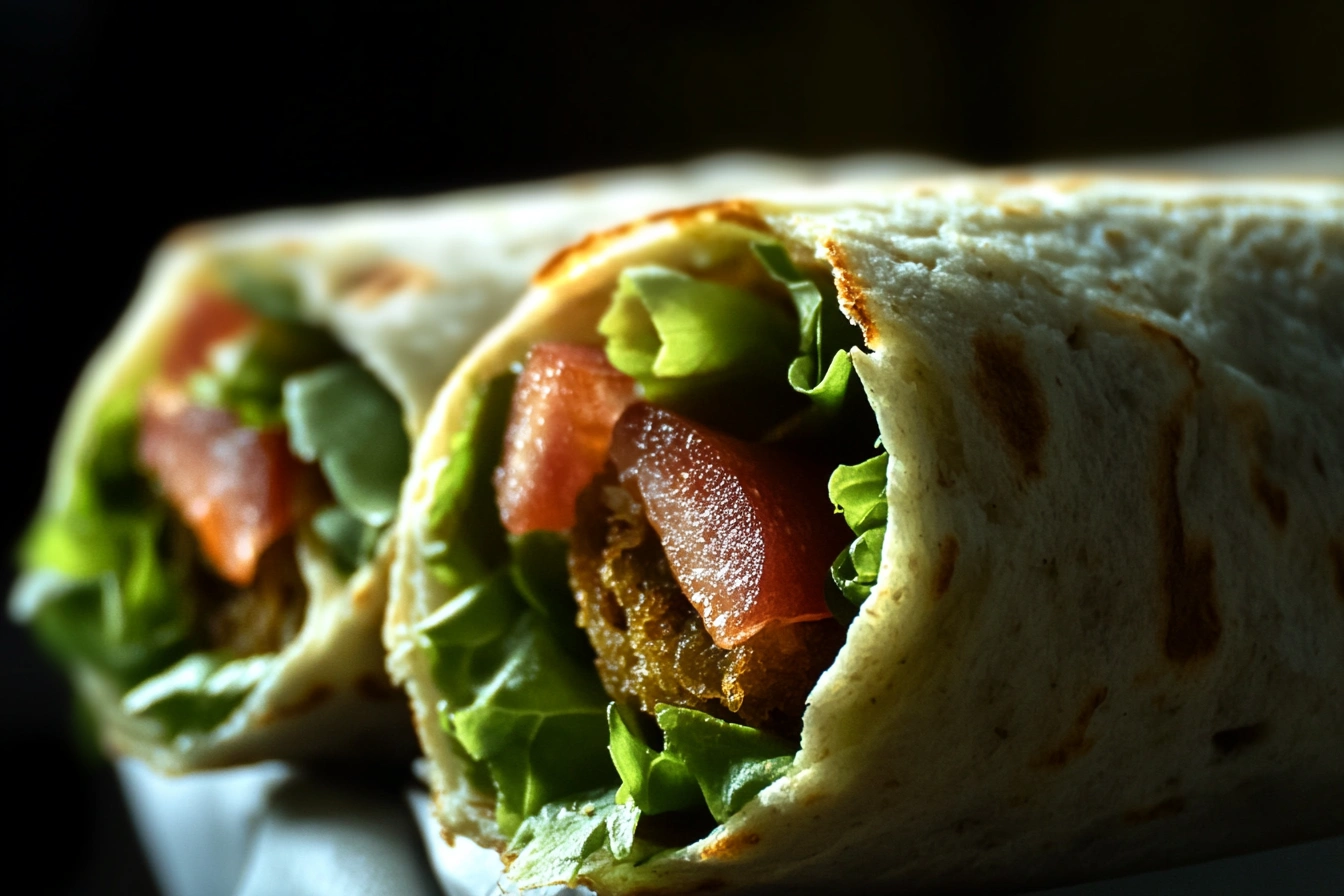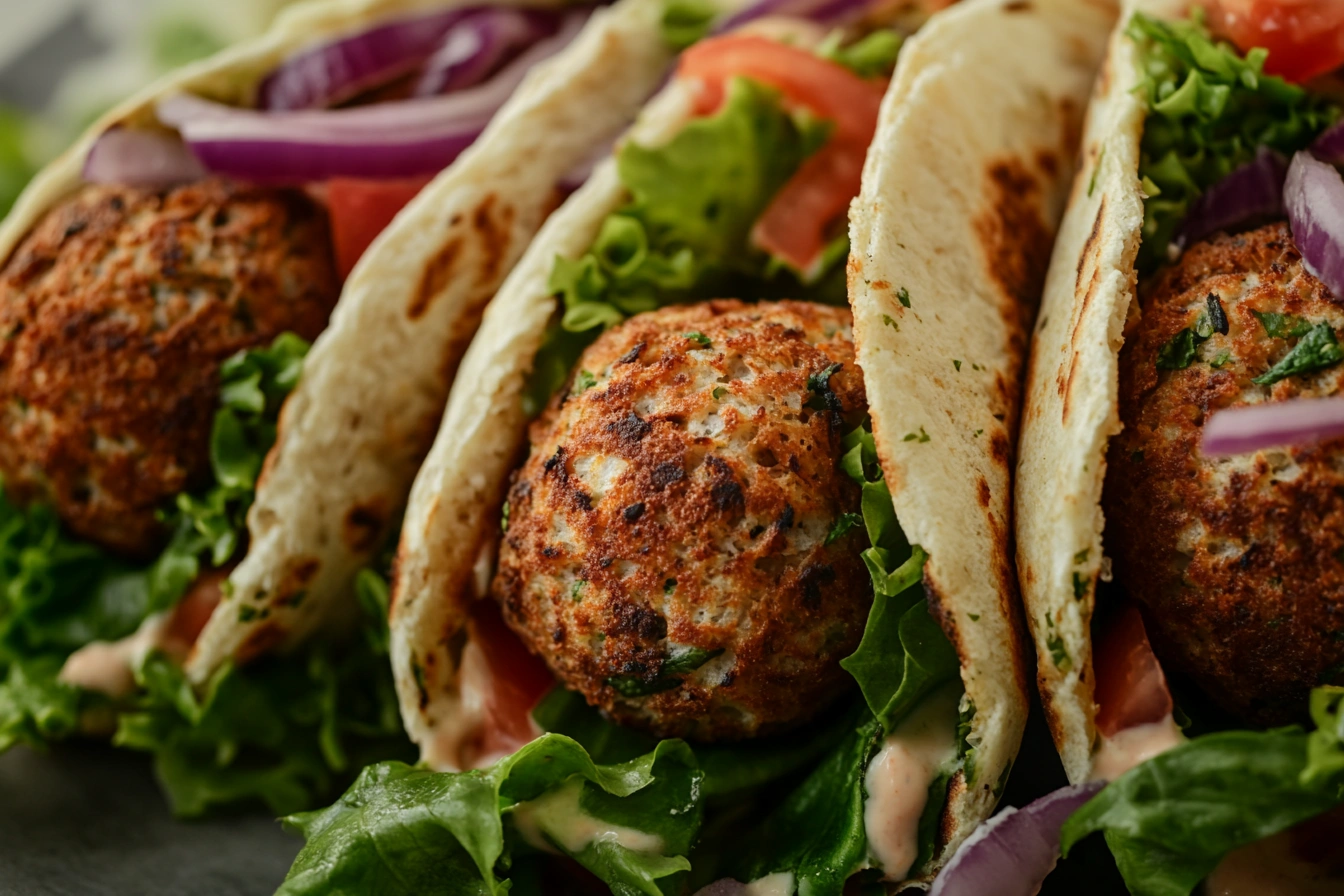Introduction & Ingredients
A falafel wrap is a delicious and satisfying dish that combines crispy falafel balls, fresh vegetables, and flavorful sauces, all wrapped in a soft flatbread. Originating from the Middle East, falafel has become a globally loved street food, appreciated for its vegetarian-friendly, high-protein, and customizable nature. This section will explore what a falafel wrap is, its essential ingredients, and the many variations that make it suitable for different diets.
Table of Contents
1.1 What Is a Falafel Wrap?
A falafel wrap is a Middle Eastern-inspired dish made by wrapping crispy falafel balls in pita bread or flatbread, along with fresh vegetables, pickled toppings, and sauces like tahini or garlic yogurt sauce. It is a popular plant-based meal that is both nutritious and satisfying.
📜 The Origins of Falafel
Falafel is believed to have originated in the Middle East, with countries like Egypt, Lebanon, and Israel all claiming it as a national dish.
✔ Egyptian Falafel (Ta’ameya) – Traditionally made with fava beans, giving it a softer texture.
✔ Lebanese & Israeli Falafel – Typically made with chickpeas, resulting in a firmer, crunchier falafel ball.
✔ Traditional Cooking Method – The falafel mixture is shaped into small balls or patties and deep-fried until crispy and golden brown.
🌟 Why Is the Falafel Wrap So Popular?
✔ Vegetarian & Vegan-Friendly – Falafel is made entirely from plant-based ingredients, making it an excellent choice for vegetarians and vegans.
✔ High in Protein & Fiber – Chickpeas and fava beans are rich in protein and fiber, which helps keep you full and supports digestion.
✔ Customizable – Falafel wraps can be modified with different fillings, sauces, and spices to suit various preferences and dietary needs.
🔹 Key Takeaway: A falafel wraps is a nutritious, flavorful, and highly customizable dish that has become a staple in Middle Eastern cuisine and beyond.
1.2 Essential Ingredients for a Falafel Wrap
The key to a great wraps is a combination of crispy falafel, fresh vegetables, and a flavorful sauce, all wrapped in soft pita or flatbread.
✔ Essential Ingredients for the Falafel
✔ Chickpeas (or Fava Beans) – The main ingredient, soaked and blended into a thick paste.
✔ Garlic, Onion, and Fresh Herbs (Parsley, Cilantro) – Adds flavor and freshness.
✔ Cumin, Coriander, and Salt – Traditional Middle Eastern spices that give falafel its signature flavor.
✔ Flour or Breadcrumbs – Helps bind the falafel mixture together.
✔ Baking Powder – Ensures a light and fluffy texture inside while keeping the outside crispy.
✔ Essential Ingredients for the Wrap
✔ Pita Bread or Flatbread – The foundation of the wrap, soft yet sturdy enough to hold the ingredients.
✔ Lettuce, Tomato, and Cucumber – Adds crunch and freshness.
✔ Pickled Vegetables (Pickles, Turnips, or Red Onions) – Provides a tangy contrast to the crispy falafel.
✔ Essential Sauces for the Wrap
✔ Tahini Sauce – A classic sesame-based sauce with lemon and garlic, adding nutty richness.
✔ Garlic Yogurt Sauce – A creamy Greek yogurt-based sauce with garlic and lemon, offering a tangy flavor.
✔ Hummus – A smooth chickpea spread, adding extra flavor and creaminess.
🔹 Key Takeaway: The perfect wrap consists of crispy falafel, fresh toppings, and a delicious sauce, all wrapped in soft, warm pita bread.
1.3 Popular Variations of Falafel Wraps
Falafel wraps are incredibly versatile, and small modifications can make them suitable for different dietary needs.
✔ Vegan Falafel Wrap
- Replace dairy-based sauces with tahini sauce or dairy-free garlic sauce.
- Use olive oil instead of butter in the sauce.
✔ Gluten-Free Falafel Wrap
- Use gluten-free pita bread or wrap the falafel in lettuce leaves.
- Ensure the falafel mixture is made without breadcrumbs or wheat flour (use chickpea flour instead).
✔ Low-Carb Falafel Wrap
- Replace pita bread with lettuce wraps or collard greens to reduce carbs.
- Serve falafel with cauliflower rice or a Mediterranean salad instead of wrapping it in bread.
✔ Spicy Falafel Wrap
- Add harissa sauce, sriracha, or red chili flakes to the falafel mixture or sauce.
- Include jalapeños or spicy pickled peppers in the wrap for an extra kick.
✔ Mediterranean Falafel Wrap
- Add feta cheese, olives, and tzatziki sauce for a Greek-inspired flavor.
- Include roasted red peppers or sun-dried tomatoes for extra depth.
🔹 Key Takeaway: Falafel wraps can be easily customized to fit different dietary preferences, whether vegan, gluten-free, low-carb, or extra spicy.

How to Make a Falafel Wrap
A falafel wrap is a delicious, satisfying, and versatile meal that can be easily prepared at home. Whether you prefer the traditional deep-fried falafel or a healthier baked or air-fried version, making falafel from scratch ensures the best flavor and texture. This section provides a step-by-step guide to making homemade falafel, explores healthier cooking methods, and highlights the best sauces to pair with your wrap.
2.1 Step-by-Step Recipe for Homemade Falafel
Making falafel at home is easier than you might think! Follow these steps to create the perfect falafel wrap from scratch.
✔ Step 1: Prepare the Falafel Mixture
1️⃣ Soak the Chickpeas
- Use dried chickpeas, not canned, for the best texture.
- Soak them in water overnight (8-12 hours) to soften them.
- Drain and rinse the chickpeas before using.
2️⃣ Blend the Ingredients
- In a food processor, blend the soaked chickpeas with:
✔ Garlic & Onion – Adds depth of flavor.
✔ Fresh Herbs (Parsley & Cilantro) – Enhances freshness and color.
✔ Spices (Cumin, Coriander, Salt, Black Pepper, Paprika) – Essential for the authentic falafel taste.
3️⃣ Add Binders
- Mix in flour or breadcrumbs to help hold the falafel together.
- Add baking powder to create a light and fluffy texture.
4️⃣ Let the Mixture Rest
- Transfer the falafel mixture to a bowl and let it rest for 30 minutes in the refrigerator.
- This step helps develop flavors and firm up the mixture for shaping.
✔ Step 2: Shape and Cook the Falafel
1️⃣ Shape the Falafel
- Use your hands or a scoop to form small balls or patties (about the size of a golf ball).
2️⃣ Choose a Cooking Method
- Deep-Fry (Traditional Method) – Fry the falafel in hot oil (350°F/175°C) until golden brown.
- Bake (Healthier Option) – Arrange falafel on a lined baking sheet, drizzle with oil, and bake at 375°F (190°C) for 25-30 minutes, flipping halfway through.
- Air-Fry (Crispy & Healthy) – Lightly brush falafel with oil and air-fry at 375°F (190°C) for 12-15 minutes.
3️⃣ Drain & Cool
- Place the cooked falafel on paper towels to remove excess oil (if deep-frying).
✔ Step 3: Assemble the Wrap
1️⃣ Warm the Bread
- Heat pita bread or flatbread on a skillet or in the oven for a few minutes.
2️⃣ Spread the Base Sauce
- Spread a layer of hummus or tahini sauce on the bread to add creaminess and prevent dryness.
3️⃣ Add the Vegetables
- Layer with lettuce, tomatoes, cucumbers, and pickled vegetables.
4️⃣ Place the Falafel
- Add 3-4 crispy falafel balls on top of the vegetables.
5️⃣ Drizzle with Sauce
- Add garlic yogurt sauce, extra tahini, or hot sauce for more flavor.
6️⃣ Wrap & Serve!
- Fold the sides and wrap it tightly. Serve immediately while warm!
🔹 Key Takeaway: Making homemade falafel is easy and rewarding! Preparing the mixture, choosing the right cooking method, and assembling the wrap with fresh ingredients results in a delicious meal.
2.2 Healthier Cooking Methods for Falafel
Traditional falafel is deep-fried, which gives it a crispy texture but also adds extra oil and calories. Here are some alternative cooking methods to make your falafel wrap healthier.
✔ Deep-Frying (Traditional Method)
✔ Pros:
- Crispy exterior with a soft, fluffy inside.
- The most authentic and flavorful falafel.
🚫 Cons:
- High in oil and calories.
- Less suitable for people watching their fat intake.
✔ Baking (Healthier Option)
✔ Pros:
- Uses less oil while still being flavorful.
- Great for meal prep since they reheat well.
🚫 Cons:
- May be less crispy than deep-fried falafel.
Tip: Lightly coat falafel with olive oil before baking for extra crispiness.
✔ Air-Frying (Best of Both Worlds)
✔ Pros:
- Much lower in fat than deep-frying.
- Creates a crispy outer layer while keeping the inside soft.
- Faster cooking time (only 12-15 minutes).
🚫 Cons:
- Slightly drier than deep-fried falafel.
🔹 Key Takeaway: For a healthier falafel wrap, bake or air-fry your falafel instead of deep-frying. Air-frying offers the best balance of crispiness and lower fat content.
2.3 Best Sauces to Pair with a Falafel Wrap
A falafel wrap isn’t complete without a flavorful sauce! The right sauce can enhance the taste and provide extra moisture. Here are the best sauces to complement your falafel wrap.
✔ Tahini Sauce (Classic Choice)
- Main Ingredients:
✔ Tahini (sesame paste)
✔ Lemon juice
✔ Garlic
✔ Water & salt - Why It Works:
- Rich, nutty flavor that complements falafel.
- Vegan & dairy-free.
✔ Garlic Yogurt Sauce (Tangy & Creamy)
- Main Ingredients:
✔ Greek yogurt
✔ Garlic & lemon juice
✔ Olive oil & salt - Why It Works:
- Adds a creamy, tangy taste.
- Cooling effect balances the spices in falafel.
✔ Hummus (Smooth & Rich)
- Main Ingredients:
✔ Chickpeas
✔ Tahini
✔ Lemon juice & garlic - Why It Works:
- Adds extra protein and fiber.
- Provides a creamy texture without dairy.
✔ Spicy Harissa Sauce (For Heat Lovers)
- Main Ingredients:
✔ Red chili peppers
✔ Garlic & cumin
✔ Lemon juice & olive oil - Why It Works:
- Adds spice and depth to the wrap.
- A great choice for those who love bold flavors.
✔ Zhoug (Spicy Cilantro Sauce)
- Main Ingredients:
✔ Cilantro & parsley
✔ Green chilies & garlic
✔ Cumin & olive oil - Why It Works:
- Bright, herby flavor that enhances falafel.
- Adds a Middle Eastern twist to the wrap.
🔹 Key Takeaway: Different sauces can completely change the flavor profile of a falafel wrap, making it mild, tangy, or spicy. Choose a sauce based on your preference!

FAQs – People Also Ask
Falafel wraps are popular worldwide, but many people have questions about their health benefits, calories, and dietary adaptability. Below, we answer some of the most frequently asked questions about falafel wraps.
Is a Falafel Wrap Healthy?
✔ Yes! Falafel is high in protein, fiber, and plant-based nutrients.
Chickpeas (the main ingredient) are rich in fiber, protein, and essential vitamins like iron and magnesium.
Falafel wraps contain fresh vegetables, making them a balanced meal with fiber and healthy fats.
🚫 Deep-fried falafel may be high in calories and fat.
Traditional falafel is deep-fried, which adds extra oil and calories.
A deep-fried falafel wrap with sauces like tahini or garlic mayo can be higher in fat.
✔ Using whole wheat pita and healthier cooking methods makes it even healthier.
Baking or air-frying falafel reduces the oil content significantly.
Using whole wheat pita instead of white pita increases fiber and makes the wrap more filling.
🔹 Key Takeaway: Falafel wraps can be very healthy when made with nutritious ingredients and healthier cooking methods.
How Many Calories Are in a Falafel Wrap?
✔ A standard falafel wrap has around 400-600 calories, depending on sauces and toppings.
A falafel wrap with pita, falafel, and vegetables is typically on the lower end of the calorie range.
Adding hummus, tahini, or extra sauce increases the calorie count.
🚫 Adding extra sauces or deep-frying the falafel can increase calorie content.
Deep-fried falafel absorbs oil, adding about 50-100 extra calories per serving.
Tahini sauce, hummus, and garlic yogurt sauce are calorie-dense, so portion control is key.
✔ A baked or air-fried falafel wrap with lighter sauces can be under 400 calories.
Choosing baked or air-fried falafel reduces calorie intake.
Using a whole wheat or low-carb wrap can also lower the calorie count.
🔹 Key Takeaway: Falafel wraps range from 400-600 calories, but using healthier cooking methods and portioning sauces wisely can keep them on the lower end.
Can You Make Falafel Wraps Gluten-Free?
✔ Yes! Use gluten-free pita bread or lettuce wraps.
Many stores offer gluten-free pita or tortillas for those with gluten sensitivity.
If you can’t find gluten-free pita, lettuce wraps or collard greens work as a great alternative.
✔ Ensure the falafel mixture does not contain flour with gluten.
Some falafel recipes use breadcrumbs or wheat flour as a binder.
To keep it gluten-free, use chickpea flour or ground oats instead.
🔹 Key Takeaway: Falafel wraps can easily be made gluten-free by using the right ingredients and alternative wraps.
Is a Falafel Wrap Good for Weight Loss?
✔ Yes, if made with whole ingredients and lighter sauces.
Falafel is naturally rich in fiber and protein, helping you feel full longer.
Using fresh vegetables and whole wheat pita makes it a nutrient-dense meal.
🚫 Deep-fried falafel and extra sauces can make it high in fat.
A falafel wrap with too much tahini or fried falafel can be calorie-dense and may slow weight loss.
Reducing oil, using lighter sauces, and controlling portion sizes make it a better option for weight loss.
Tips for a Weight-Loss-Friendly Falafel Wrap:
✔ Bake or air-fry falafel instead of deep-frying.
✔ Use a whole wheat or low-carb wrap.
✔ Go easy on high-calorie sauces like tahini and hummus.
✔ Fill your wrap with extra fresh vegetables for fiber and volume.
🔹 Key Takeaway: A falafel wrap can be a great weight-loss meal when made with fresh, whole ingredients and lighter sauces.
Can You Make a Falafel Wrap Without a Wrap?
✔ Yes! Try a falafel bowl with salad, quinoa, or cauliflower rice.
If you want to skip the wrap, turn your falafel into a bowl with:Chopped greens (lettuce, kale, spinach).
Cooked grains (quinoa, couscous, or brown rice).
Fresh vegetables and sauces.
✔ Use large lettuce leaves instead of pita for a low-carb option.
If you’re following a low-carb or keto diet, try:Lettuce wraps (romaine or iceberg lettuce).
Collard greens or cabbage leaves as a wrap alternative.
🔹 Key Takeaway: You can enjoy falafel without a wrap by making a salad bowl or using lettuce wraps as a low-carb alternative.
Final Thoughts
✔ Falafel wraps are a healthy and delicious plant-based meal that can be customized to fit various diets.
✔ They are high in fiber and protein but can become high in calories if deep-fried or loaded with sauces.
✔ Gluten-free and low-carb versions are easy to make using alternative wraps.
✔ For weight loss, opt for baked or air-fried falafel, whole wheat wraps, and lighter sauces.
Would you like a step-by-step guide for meal-prepping falafel wraps? Let me know, and I’d be happy to share tips on storing and reheating! 🌯🔥


2 thoughts on “Falafel Wrap: Easy Recipe, Health Benefits, and Variations”